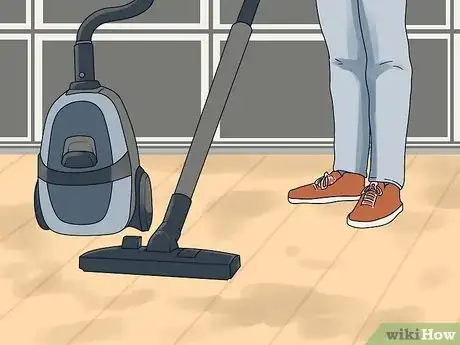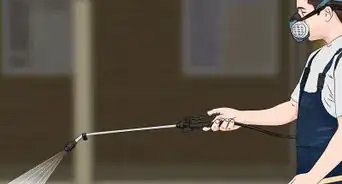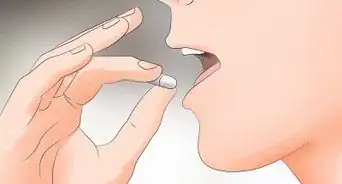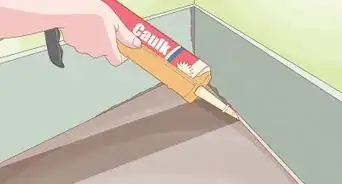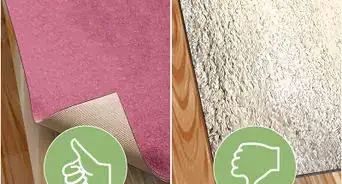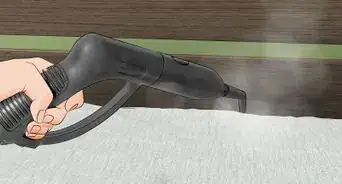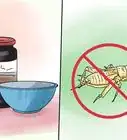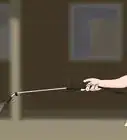This article was co-authored by Samuel Ramsey, PhD and by wikiHow staff writer, Caroline Heiderscheit. Dr. Samuel Ramsey is an Entomologist and a researcher with the United States Department of Agriculture. Dr. Ramsey has extensive knowledge of symbiosis and specializes in insect disease spread, parasite behavior, mutualism development, biological control, invasive species ecology, pollinator health, and insect pest control. He holds a Bachelor’s degree in Entomology from Cornell University and a Ph.D. in Entomology from the University of Maryland. Dr. Ramsey’s research on bees has enabled researchers to develop targeted control techniques to restore honey bee populations worldwide. He also hosts a YouTube series called “Dr. Buggs.”
There are 10 references cited in this article, which can be found at the bottom of the page.
This article has been viewed 10,673 times.
If you've spotted super large, long-legged crickets in your home, you may be dealing with spider crickets. These nasty pests can seriously alarm homeowners, but don't stress—they don't bite and aren't a health risk. If left to their own devices though, they may wreak havoc on fabrics and woods in your home. So, we'll walk you through all of the fastest, most effective extermination tips below. To learn how to easily rid your home of spider crickets once and for all, read on!
Steps
How can I get rid of spider crickets?
-
1Reduce moisture in your home with a dehumidifier. Spider crickets seek out damp, humid environments—like your muggy basement, for instance. Etymologist Samuel Ramsey emphasizes that if you "run a dehumidifier, it will dry out the air, [which] will make it a lot more difficult for [the crickets] to find a suitable habitat if they happen to make it inside." Purchase a dehumidifier online or in home-improvement stores. Once your home’s air is dry and crisp, spider crickets are likely to leave on their own.[2]
- For best effects, make sure to buy the right size. Your dehumidifier should be powerful enough to help with your entire space.
- Buy one that’s too weak, and it won't affect your air quality enough to solve your issue.
-
2Use a vacuum to suck up spider crickets and their eggs. You may not want to get close enough to squash the bugs, and we don’t blame you. Instead, thoroughly vacuum your floors, especially in your basement.This way, you can rid your home of the pests from a comfortable distance. According to Etymologist Samuel Ramsey, "crickets infrequently reproduce inside of human homes. They are most likely to reproduce outside of the home and to come into the home itself through cracks and crevices that they're allowed to access." However, on the off chance there are any eggs, this method can help you catch a majority of them, thus helping to prevent future spider cricket infestations.[3]
- Spider crickets can survive being vacuumed. Empty your vacuum bag immediately into an outdoor garbage bin so they don't make their way back into your home.
-
3Set store-bought traps to catch and kill spider crickets. According to Etymologist Samuel Ramsey, "there are sticky traps that can be used to capture [crickets]. They are very, very effective." Station the traps in areas where you’ve spied the bugs in the past. As long as they won't inconvenience you, place as many sticky traps as you can in as large of an area as you can. The more ground you cover, the better chance you have of catching more pests.[4]
- Spider crickets love fungi, so for extra effect, place pieces of moldy bread in the center of the traps. This will make your traps even more enticing to them!
- Even without the bread, sticky traps will catch unsuspecting bugs while they move around your home. As Etymologist Samuel Ramsey notes, "the [bug will] just [sit] there until it eventually starves."
-
4Catch spider crickets in soapy, homemade traps. In muggy areas (like your basement) or areas where you’ve spotted bugs already, leave out a big tub of water. Squirt in a little dish soap, and you'll have created your own DIY bug trap. Spider crickets will come for the water, but because of the dish soap, they'll have a difficult time getting out of your container.[5]
- The dish soap will create suds and slippery sides. The water's surface tension will break, making it more difficult for the spider crickets to stay afloat and escape.
- This is a quick, easy spider cricket killer.
-
5Call a professional if you're facing a full infestation. Spider crickets are a bit elusive because they move quickly and love warm hiding spots. If the problem has already gotten out of control, it may be extremely difficult to rid your house of the bugs yourself. So, make a call to an exterminator. When you're deciding on a service, consider asking for a free quote and references.[6]
- Pro tip: ask fellow homeowners for their recommendations on the best local pest control.
Spider Cricket Prevention
-
1Seal up your home's entryways with sealant and weatherproofing. According to Etymologist Samuel Ramsey, "One of the clearest reasons why people have homes full of crickets are that they have pest entry points on the outside of their home that allow these organisms to easily get inside. [...] [For example], if you're approaching the stoop and you have a concrete foundation and you see the large cracks that are going toward the house itself, it’s easy for creatures like crickets that live in the soil to cross through that broken barrier and to get into the home that way." Walk around your house, keeping an eye out for cracks, holes, crawlspaces, vents, and voids. Seal up any potential entry points for a cold or hungry spider cricket. For an immediate solution, use caulk sealant. For long-term solutions, try a concrete filler.[7]
- Next, turn your attention to windows and doors. Use sealant or weather-stripping to ensure no spider crickets can get into your home.
- If spider crickets can't get into your home, then they can't infest your home. Etymologist Samuel Ramsey explains that "they are most likely to reproduce outside of the home," so they're probably coming from the outside.
-
2Declutter your home to discourage future infestations. Spider crickets love the warmth and darkness of your messy piles on the floor—so tidy up. Cardboard boxes stored in a humid basement are specially enticing for the crickets. According to Etymologist Samuel Ramsey, "[crickets] can feed on the paper fibers that the cardboard is made out of, as [it's] a good source of sugar and food for them. But, in addition to that, when cardboard is allowed to sit for long periods of time, especially if it gets a bit damp, small amounts of micro-fungi grow on it that the crickets are attracted to and consume."
- Plus, by keeping your floors free, you're more likely to spot spider crickets sooner. This will make it easier to get rid of spider crickets in your basement in the future.
- If you need to store items, especially in a humid part of your home, use airtight containers. Avoid leaving food out and clean up crumbs and spills right away to deter spider crickets from entering your home in search of their next meal.[8]
-
3Tidy up the outdoor perimeter bordering your home. If spider crickets are comfortable in the area surrounding your home, then eventually, they could move indoors. Mow the weed and grass areas around your home regularly, because spider crickets are more likely to live in long grasses over short, manicured yards. Keep high-moisture yard features away from your walls—like mulch piles, woodpiles, and shrubs.[9]
Expert Q&A
-
QuestionHow do you kill a lot of crickets?
 Samuel Ramsey, PhDDr. Samuel Ramsey is an Entomologist and a researcher with the United States Department of Agriculture. Dr. Ramsey has extensive knowledge of symbiosis and specializes in insect disease spread, parasite behavior, mutualism development, biological control, invasive species ecology, pollinator health, and insect pest control. He holds a Bachelor’s degree in Entomology from Cornell University and a Ph.D. in Entomology from the University of Maryland. Dr. Ramsey’s research on bees has enabled researchers to develop targeted control techniques to restore honey bee populations worldwide. He also hosts a YouTube series called “Dr. Buggs.”
Samuel Ramsey, PhDDr. Samuel Ramsey is an Entomologist and a researcher with the United States Department of Agriculture. Dr. Ramsey has extensive knowledge of symbiosis and specializes in insect disease spread, parasite behavior, mutualism development, biological control, invasive species ecology, pollinator health, and insect pest control. He holds a Bachelor’s degree in Entomology from Cornell University and a Ph.D. in Entomology from the University of Maryland. Dr. Ramsey’s research on bees has enabled researchers to develop targeted control techniques to restore honey bee populations worldwide. He also hosts a YouTube series called “Dr. Buggs.”
Entomologist You can try sticky traps, but they will take some time to kill them all. There are also formulations of broad spectrum insecticides that can be sprayed outside of your house, but I actually do not recommend that, as some of them impact hundreds of different species of insects. So, if you're spraying them directly on the soil, you're probably going to kill a lot of beneficial insects in addition to the crickets themselves.
You can try sticky traps, but they will take some time to kill them all. There are also formulations of broad spectrum insecticides that can be sprayed outside of your house, but I actually do not recommend that, as some of them impact hundreds of different species of insects. So, if you're spraying them directly on the soil, you're probably going to kill a lot of beneficial insects in addition to the crickets themselves.
References
- ↑ https://www.pestworld.org/pest-guide/occasional-invaders/camel-crickets/
- ↑ https://www.epa.gov/mold/what-are-main-ways-control-moisture-your-home
- ↑ https://hgic.clemson.edu/factsheet/camel-crickets/
- ↑ https://hgic.clemson.edu/factsheet/camel-crickets/
- ↑ https://nature.berkeley.edu/~oboyski67/download/collecting.htm
- ↑ https://www.epa.gov/safepestcontrol/tips-selecting-pest-control-service
- ↑ https://hgic.clemson.edu/factsheet/camel-crickets/
- ↑ https://www.wral.com/how-to-get-rid-of-spider-crickets/14644939/
- ↑ https://hgic.clemson.edu/factsheet/camel-crickets/


